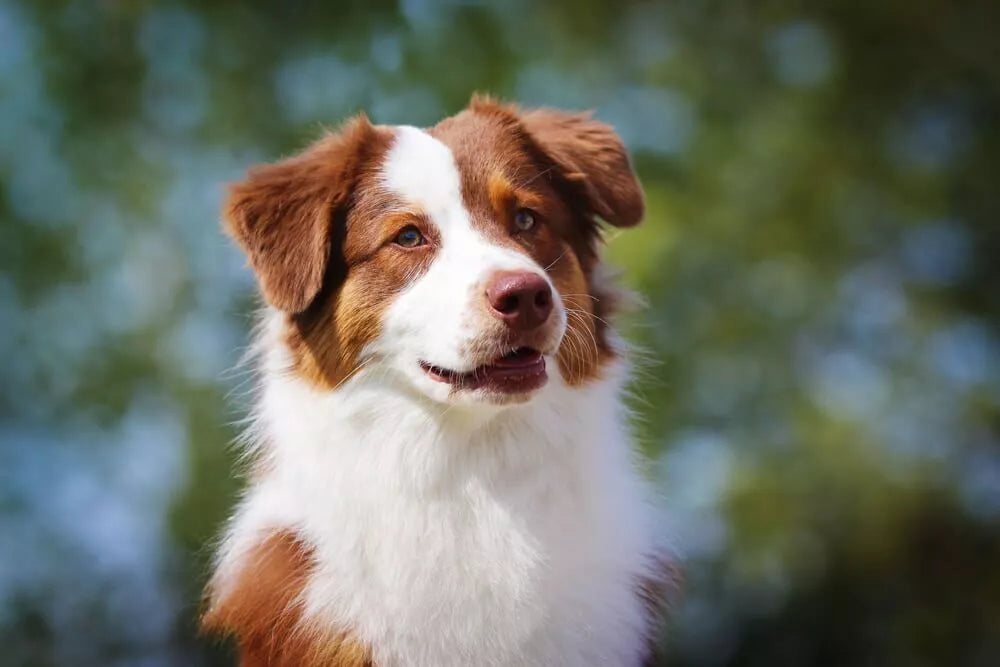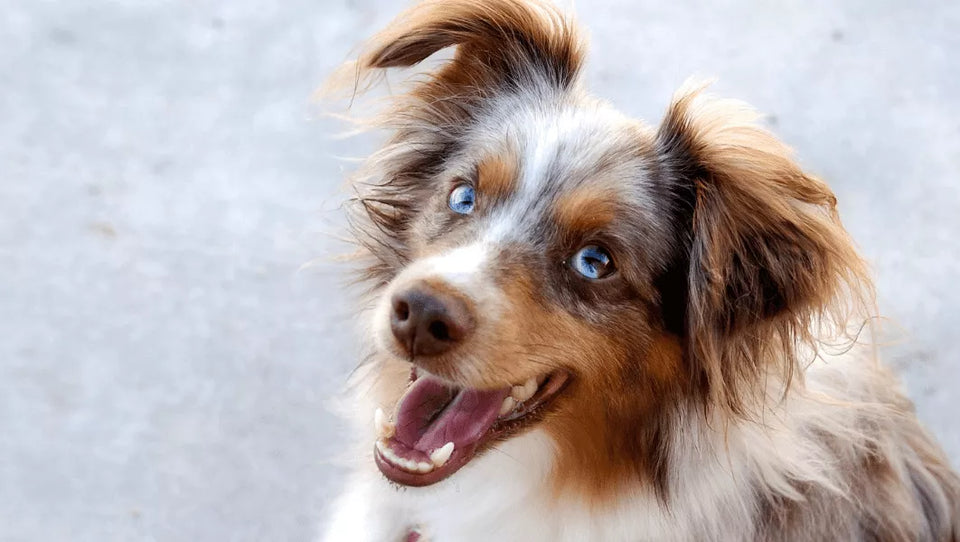The Australian shepherd was recognized as a breed by the American kennel club in 1991. The red Australian Shepherd is a recognized color alongside black, blue merle, and red merle. They can be smooth or rough-coated.
Origins
This breed was originally used for herding and was very good at its job. They are still a popular choice on cattle ranches today across America. They are fearless and speedy, with a reputation for being able to turn on a dime making them excellent cattle driving dogs. Some Australian Shepherds have short or ‘bobbed’ tails, and this was seen as a good trail when herding, as a shorter tail is less likely to get injured by cattle legs.
Whilst called Australian Shepherds, they are not actually from Australia! No one really knows their exact origins. It’s assumed they originate from the Basque region of Spain and were exported to Australia and America around the same time. Somehow the name Australian Shepherd stuck, even though a large part of the breed development and popularity has come from its breeding lines in America.
The range of coat colors is wide but your Australian Shepherd will have the same personality traits, health predispositions, and exercise needs regardless of outside appearance.

The red coat color is recessive. Therefore the puppy will need to inherit two recessive red coat color genes to show a red coat color.
Coat genetics
To understand why Red Australian Shepherds are rare, it’s interesting to have an awareness of how coat colors are bred.
In dogs, you have two types of genes that code for physical appearance: coat color and coat pattern. Each puppy inherits one set of genes from the mother and another from the father. If a dominant gene and recessive gene are inherited, the dominant gene is the one expressed in the puppy. This is how breeders can predict roughly what coat colors and patterns their litters will be based on the parent’s DNA and colors.
The dominant coat color in Australian shepherds is black and white. This is why they are the most popular color. The red coat color is recessive. Therefore the puppy will need to inherit two recessive red coat color genes to show a red coat color. This is a much less likely occurrence, so not many red coat puppies are born.
Coat patterns
For coat pattern, the merle gene is the dominant gene, and the solid color is the recessive gene. So, merle patterns are very common as the chance of a puppy inheriting one or more dominant merle genes from its parents is high. The solid color gene is recessive, so the chances of inheriting two recessive genes are much lower.
Then, when you look at the odds of receiving four lots of recessive genes- color and pattern, it makes sense why the solid red Australian shepherd is so rare. As it is so hard to breed for this particular color combination, most breeders are not actively pursuing this coat color. It can be very hard to source a red Australian shepherd dog, and most are bred by happy accident rather than intentionally.

Red Aussies were bred for hard work, and will happily run around all day every day.
The Miniature Australian Shepherd
Another variety of the Australian Shepherd, they grow around 13-18 inches whereas an Australian Shepherd will grow to around 18-23 inches. A miniature Shepherd will weigh 18-35 pounds whereas a full-size Australian shepherd can be 35-70 pounds. Mini shepherds come in the same color varieties.
Their small size makes them suited to smaller homes providing you can still exercise them enough.
Positive traits
These dogs are fun to be around! Red Aussies were bred for hard work, and will happily run around all day every day. If you live an active lifestyle and enjoy having a second shadow, this is the dog for you.
They need a lot of exercise. Around one to two hours a day should keep your Red Aussie settled. They will enjoy a large outdoor garden, to burn off any extra steam throughout the day.
Red Aussies are thought to be hypoallergenic, which may be of interest if you have dog hair allergies.
Your Red Australian shepherd is highly intelligent. They love to have a ‘job’ or activity to keep their minds engaged such as obedience, training, or agility. Puzzle toys or brain games can keep them amused for hours at home.

The only real negative thing to be aware of for this breed is that the urge to herd is still very strong even today when the majority are kept as family companions.
Negative traits
The only real negative thing to be aware of for this breed Is that the urge to herd is still very strong even today when the majority are kept as family companions. You may find your red Aussie wants to herd everything- livestock, children, other pets, and even cars! This can be upsetting for small children, and if not stopped can lead to snapping at children which is a safety risk. Sadly this breed has a high incidence of road traffic accidents. Always keep them on the lead when in an urban environment.
Summary
The Red Australian Shepherd is a very rare occurrence, mostly due to genetic selection. There is little we can do to change this and should celebrate their unique coats and patterns when given the opportunity. Loyal, energetic, and fun, this dog will fit in well with an active family with slightly older children, or child-free owners with lots of time to spend with their dog.
FAQs:
How much is a red Australian Sheperd?
Red Australian Shepherds or Red Aussies as they are fondly called can be an expensive dog to buy. They usually cost around $700-1500 as puppies. You may be lucky and find a Red Aussie in a charity or rescue organization where the costs of adoption are much lower, usually around $300-400.
Are red Australian Shepherds Rare?
Yes, the red Australian Shepherd is a rare coat color.
What is the rarest Australian Sheperd Color?
A solid red coat color is the rarest Australian Sheperd Color.
What is a red Australian Sheperd?
This is a coat color of pure red hairs, no other hair color is present on the body. The shade of red can vary from liver to light copper, but all of the hairs must be red only to be classed as this coat color.





